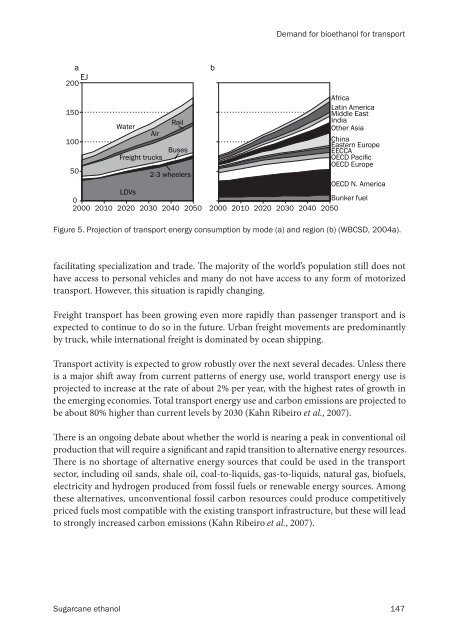Sugarcane ethanol: Contributions to climate change - BAFF
Sugarcane ethanol: Contributions to climate change - BAFF
Sugarcane ethanol: Contributions to climate change - BAFF
Create successful ePaper yourself
Turn your PDF publications into a flip-book with our unique Google optimized e-Paper software.
a<br />
EJ<br />
200<br />
b<br />
Demand for bio<strong>ethanol</strong> for transport<br />
150<br />
100<br />
50<br />
Rail<br />
Water<br />
Air<br />
Buses<br />
Freight trucks<br />
2-3 wheelers<br />
Africa<br />
Latin America<br />
Middle East<br />
India<br />
Other Asia<br />
China<br />
Eastern Europe<br />
EECCA<br />
OECD Pacific<br />
OECD Europe<br />
OECD N. America<br />
0<br />
LDVs<br />
Bunker fuel<br />
2000 2010 2020 2030 2040 2050 2000 2010 2020 2030 2040 2050<br />
Figure 5. Projection of transport energy consumption by mode (a) and region (b) (WBCSD, 2004a).<br />
facilitating specialization and trade. �e majority of the world’s population still does not<br />
have access <strong>to</strong> personal vehicles and many do not have access <strong>to</strong> any form of mo<strong>to</strong>rized<br />
transport. However, this situation is rapidly changing.<br />
Freight transport has been growing even more rapidly than passenger transport and is<br />
expected <strong>to</strong> continue <strong>to</strong> do so in the future. Urban freight movements are predominantly<br />
by truck, while international freight is dominated by ocean shipping.<br />
Transport activity is expected <strong>to</strong> grow robustly over the next several decades. Unless there<br />
is a major shi� away from current patterns of energy use, world transport energy use is<br />
projected <strong>to</strong> increase at the rate of about 2% per year, with the highest rates of growth in<br />
the emerging economies. Total transport energy use and carbon emissions are projected <strong>to</strong><br />
be about 80% higher than current levels by 2030 (Kahn Ribeiro et al., 2007).<br />
�ere is an ongoing debate about whether the world is nearing a peak in conventional oil<br />
production that will require a signi�cant and rapid transition <strong>to</strong> alternative energy resources.<br />
�ere is no shortage of alternative energy sources that could be used in the transport<br />
sec<strong>to</strong>r, including oil sands, shale oil, coal-<strong>to</strong>-liquids, gas-<strong>to</strong>-liquids, natural gas, biofuels,<br />
electricity and hydrogen produced from fossil fuels or renewable energy sources. Among<br />
these alternatives, unconventional fossil carbon resources could produce competitively<br />
priced fuels most compatible with the existing transport infrastructure, but these will lead<br />
<strong>to</strong> strongly increased carbon emissions (Kahn Ribeiro et al., 2007).<br />
<strong>Sugarcane</strong> <strong>ethanol</strong> 147












